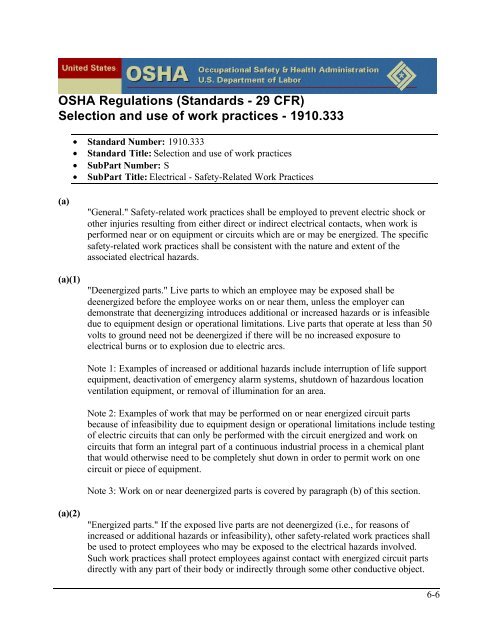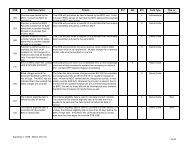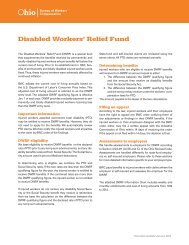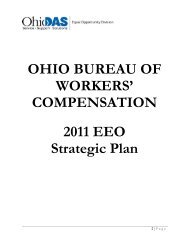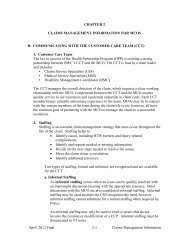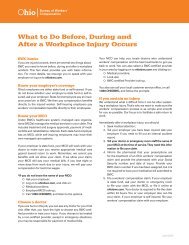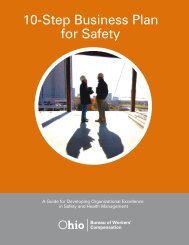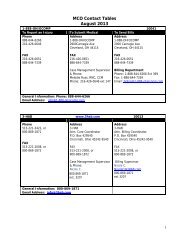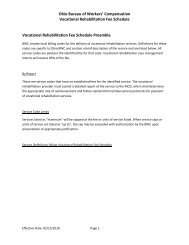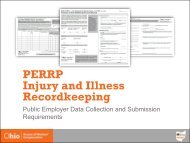Lockout / Tagout - Ohio Bureau of Workers' Compensation
Lockout / Tagout - Ohio Bureau of Workers' Compensation
Lockout / Tagout - Ohio Bureau of Workers' Compensation
Create successful ePaper yourself
Turn your PDF publications into a flip-book with our unique Google optimized e-Paper software.
OSHA Regulations (Standards - 29 CFR)<br />
Selection and use <strong>of</strong> work practices - 1910.333<br />
• Standard Number: 1910.333<br />
• Standard Title: Selection and use <strong>of</strong> work practices<br />
• SubPart Number: S<br />
• SubPart Title: Electrical - Safety-Related Work Practices<br />
(a)<br />
(a)(1)<br />
"General." Safety-related work practices shall be employed to prevent electric shock or<br />
other injuries resulting from either direct or indirect electrical contacts, when work is<br />
performed near or on equipment or circuits which are or may be energized. The specific<br />
safety-related work practices shall be consistent with the nature and extent <strong>of</strong> the<br />
associated electrical hazards.<br />
"Deenergized parts." Live parts to which an employee may be exposed shall be<br />
deenergized before the employee works on or near them, unless the employer can<br />
demonstrate that deenergizing introduces additional or increased hazards or is infeasible<br />
due to equipment design or operational limitations. Live parts that operate at less than 50<br />
volts to ground need not be deenergized if there will be no increased exposure to<br />
electrical burns or to explosion due to electric arcs.<br />
Note 1: Examples <strong>of</strong> increased or additional hazards include interruption <strong>of</strong> life support<br />
equipment, deactivation <strong>of</strong> emergency alarm systems, shutdown <strong>of</strong> hazardous location<br />
ventilation equipment, or removal <strong>of</strong> illumination for an area.<br />
Note 2: Examples <strong>of</strong> work that may be performed on or near energized circuit parts<br />
because <strong>of</strong> infeasibility due to equipment design or operational limitations include testing<br />
<strong>of</strong> electric circuits that can only be performed with the circuit energized and work on<br />
circuits that form an integral part <strong>of</strong> a continuous industrial process in a chemical plant<br />
that would otherwise need to be completely shut down in order to permit work on one<br />
circuit or piece <strong>of</strong> equipment.<br />
Note 3: Work on or near deenergized parts is covered by paragraph (b) <strong>of</strong> this section.<br />
(a)(2)<br />
"Energized parts." If the exposed live parts are not deenergized (i.e., for reasons <strong>of</strong><br />
increased or additional hazards or infeasibility), other safety-related work practices shall<br />
be used to protect employees who may be exposed to the electrical hazards involved.<br />
Such work practices shall protect employees against contact with energized circuit parts<br />
directly with any part <strong>of</strong> their body or indirectly through some other conductive object.<br />
6-6


